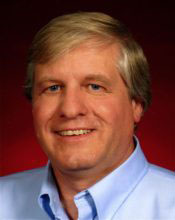 Professor Scott Emr will give the 2013 Milstein Lecture on Thursday 26 September at 4.15pm in the LMB’s Max Perutz Lecture Theatre. The lecture, entitled “Sorting out protein traffic: Ubiquitin-mediated endocytosis and a membrane protein’s final ESCRT”, is open to anyone in the local area who is interested in attending.
Professor Scott Emr will give the 2013 Milstein Lecture on Thursday 26 September at 4.15pm in the LMB’s Max Perutz Lecture Theatre. The lecture, entitled “Sorting out protein traffic: Ubiquitin-mediated endocytosis and a membrane protein’s final ESCRT”, is open to anyone in the local area who is interested in attending.
Scott is currently Professor of Molecular Biology and Genetics, and Director of the Weill Institute for Cell and Molecular Biology, at Cornell University. He is also a member of the National Academy of Sciences, the American Academy of Arts and Sciences and an Associate (Foreign) member of the European Molecular Biology Organisation.
Scott was awarded his PhD in molecular genetics at Harvard University in 1981. He then spent two years as a postdoc at the University of California, Berkeley before moving to the California Institute of Technology as an Assistant/Associate Professor. In 1991 he became a Distinguished Professor at the University of California, San Diego, before moving to the Weill Institute at Cornell University in 2007.
Lecture abstract:
Down-regulation of cell surface receptors and transporters is mediated by a series of membrane trafficking steps including ubiquitin-mediated endocytosis, ESCRT-mediated cargo(Ub) recognition, sorting and packaging into vesicles that bud into the lumen of the endosome (ILVs), and endosome-lysosome fusion. We have focused our efforts on two stages of this pathway:
- Ub-mediated endocytosis – We have shown that the E3 ubiquitin ligase Rsp5, the yeast homolog of Nedd4, is a key mediator of protein quality control at the PM. Proteotoxic stress triggers global activation of Rsp5-dependent ubiquitination, endocytosis, and lysosomal trafficking of PM proteins. Yeast mutants defective in this process are highly sensitive to proteotoxic stress. This stress-induced endocytosis system is mediated by a family of Rsp5 adaptors known as arrestin-related trafficking adaptors (or ARTs), which target Rsp5 ubiquitin ligase activity to specific PM proteins. We propose that the ubiquitin-mediated ART-Rsp5 network protects the cell from proteotoxic stress by limiting the toxic accumulation of misfolded integral membrane proteins in the PM.
- ILV formation – The endosomal sorting complexes required for transport (ESCRTs) have emerged as key cellular machinery that drive topologically unique membrane deformation and scission events. These five protein complexes function at the endosome as a ubiquitin-dependent protein sorting machine which recognizes and sorts Ub-cargo into vesicles that bud into the lumen of the endosome (ILVs). We have evidence indicating that the ESCRT-III complex functions as a vesicle budding machine. Soluble ESCRT-III subunits assemble in vitro on lipid monolayers to generate long ~9nm-wide protofilaments composed of two ~4nm sub-filaments. These protofilaments form 3-D helices that can stabilize the necks of membrane invaginations. Understanding how the ESCRT-III polymer interacts with membranes, promoting and stabilizing membrane deformation, is an important step in elucidating ILV formation. We have identified an essential N-terminal motif on Snf7 that anchors the ESCRT-III polymer to the membrane. We propose that ESCRT-III utilizes membrane insertion and oligomeric scaffolding to drive vesicle formation.
Background information:
The Milstein Lecture, named in honour of the LMB Nobel Laureate César Milstein, is one of a series of lectures organised by the LMB and given by eminent scientists from around the world. César was born in Argentina in 1927. After completing PhDs in both Buenos Aires and Cambridge, and a brief spell of research back in Argentina, he joined the LMB in 1963 and spent the rest of his life here. He developed an early interest in immunology, and his research concentrated on antibody structure and diversity. In the early 1970′s he and his post-doc Georges Köhler developed the technique to produce monoclonal antibodies, for which they were jointly awarded the 1984 Nobel Prize in Physiology and Medicine. This technique has been used for diagnostics and developed further by LMB colleagues for therapeutic applications, leading to the creation of several MRC spin-out companies. César continued his research on how somatic mutation arises in immunoglobulin genes. He died in Cambridge on 24 March 2002.